How Come Animals Can Survive In Chernobyl
The guards caring for Chernobyl'due south abandoned dogs
(Image credit:
Sean Gallup/Getty Images
)
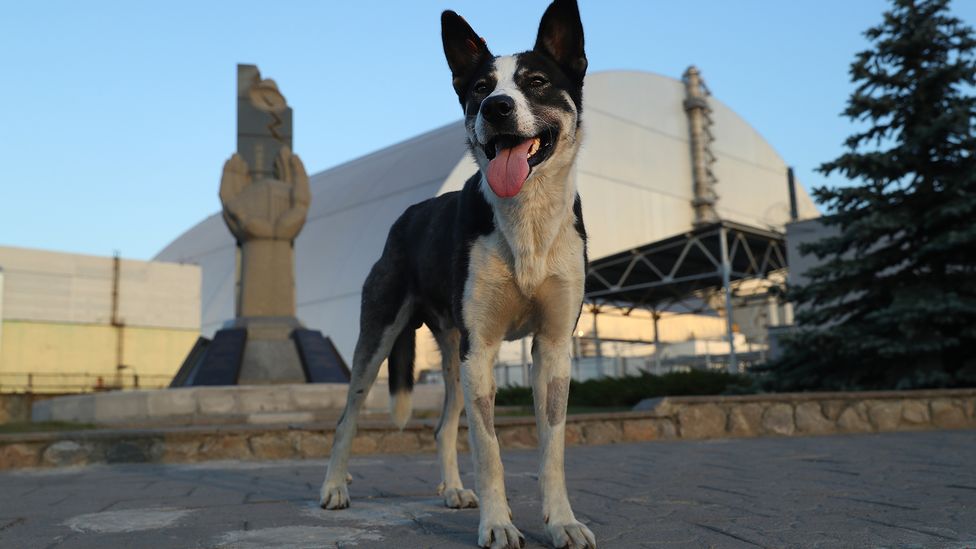
The descendants of pets abandoned by those fleeing the Chernobyl disaster are now hitting up a curious relationship with humans charged with guarding the contaminated expanse.
A
Equally we head towards the end of some other extraordinary year, BBC Future is taking a await back at some of our favourite stories for our "Best of 2021" collection. Discover more of our picks here.
It wasn't long after he arrived in the irradiated landscape of the Chernobyl Exclusion Zone that Bogdan realised his new job came with some unexpected companions. From his first days as a checkpoint guard in Chernobyl, he has shared the place with a pack of dogs.
Bogdan (not his real name) is now in his second year of working in the zone and has got to know the dogs well. Some take names, some don't. Some stay nearby, others remain discrete – they come up and get equally they delight. Bogdan and the other guards feed them, offer them shelter, and occasionally give them medical care. They coffin them when they die.
All the dogs are, in a sense, refugees of the 1986 disaster in which Reactor No. four at the Chernobyl Nuclear Power Plant exploded. In the aftermath, tens of thousands of people were evacuated from the Ukrainian urban center of Pripyat. They were told to leave their pets behind. (Read more than about the long-term cost of the Chernobyl disaster.)
Soviet soldiers shot many of the abased animals in an effort to foreclose the spread of contamination. But, undoubtedly, some of the animals hid and survived. Thirty-five years later, hundreds of stray dogs now roam the 2,600km (ane,000 sq mile) Exclusion Zone put in place to restrict human traffic in and out of the area. Nobody knows which of the dogs are directly descended from stranded pets, and which may take wandered into the zone from elsewhere. But they are all dogs of the zone now.
Their lives are perilous. They are at risk from radioactive contamination, wolf attacks, wildfires and starvation, among other threats. The dogs' average lifespan is just v years, according to the Clean Futures Fund, a non-governmental organization that monitors and provides care for dogs living inside the Exclusion Zone.
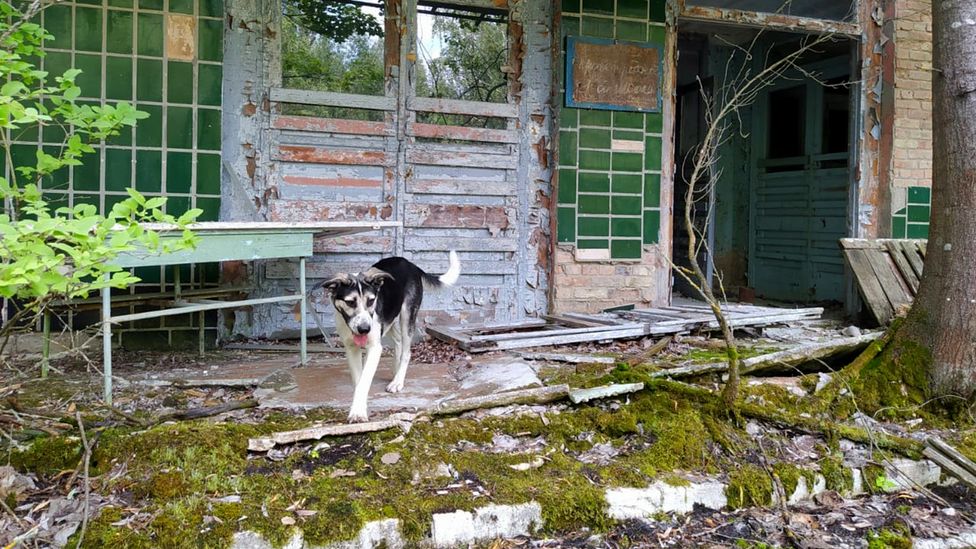
Some dogs living in the Exclusion Zone may exist descendants of pets abandoned during the 1986 evacuation but others may have wandered in (Credit: Chernobyl Guards/Jonathon Turnbull)
That dogs inhabit this ruined identify is well known – some of them have fifty-fifty become pocket-sized celebrities on social media. Clean Futures Fund co-founder Lucas Hixson, who gave up a enquiry career to wait afterward the animals, offers virtual tours of the Exclusion Zone featuring the dogs.
Merely less is known well-nigh the local workers who interact with these canines on a daily basis.
Jonathon Turnbull, a PhD candidate in geography at the University of Cambridge, realised information technology might exist worth collecting these people's stories.
"If I wanted to know the dogs," he says, "I needed to become to the people who know them best – and that was the guards."
What he discovered is a heart-warming story of the guards' relationship with the animals they encounter in this abased environment – a tale that provides insights into the deep bail between humans and dogs.
For instance, the guards have given several of the dogs nicknames. Co-ordinate to Turnbull, at that place'due south Blastoff, whose name refers to a type of radiation, and Tarzan, a dog well-known to Chernobyl tourists, who tin can do tricks on command and who lives near the famous Duga radar installation built past the Soviets. Then there is Sausage – a brusk, fat dog that likes to warm herself in the winter by lying on heating pipes. These pipes serve one of the buildings used by workers in the Exclusion Zone who are part of ongoing efforts to decommission and decontaminate the ruined ability plant.
Admission to the Chernobyl Exclusion Zone requires a permit, so guards are tasked with controlling checkpoints on roads in and out of the surface area. People who dodge these checkpoints to trespass in the Exclusion Zone are known equally "stalkers". Guards report them to the police.
When Turnbull, who lives in Ukraine's capital Kyiv, started making regular visits to the zone, he met Bogdan, and other checkpoint guards. They were reluctant to talk at first and then he had to win them over. Then he offered them to chance to take part in his enquiry, which he says was a "turning point". His thought was to give the guards disposable cameras and ask them to take pictures of the dogs – not posed portraits only scenes of everyday life. The guards but had 1 other asking - "delight, please – bring food for the dogs". And so Turnbull did.
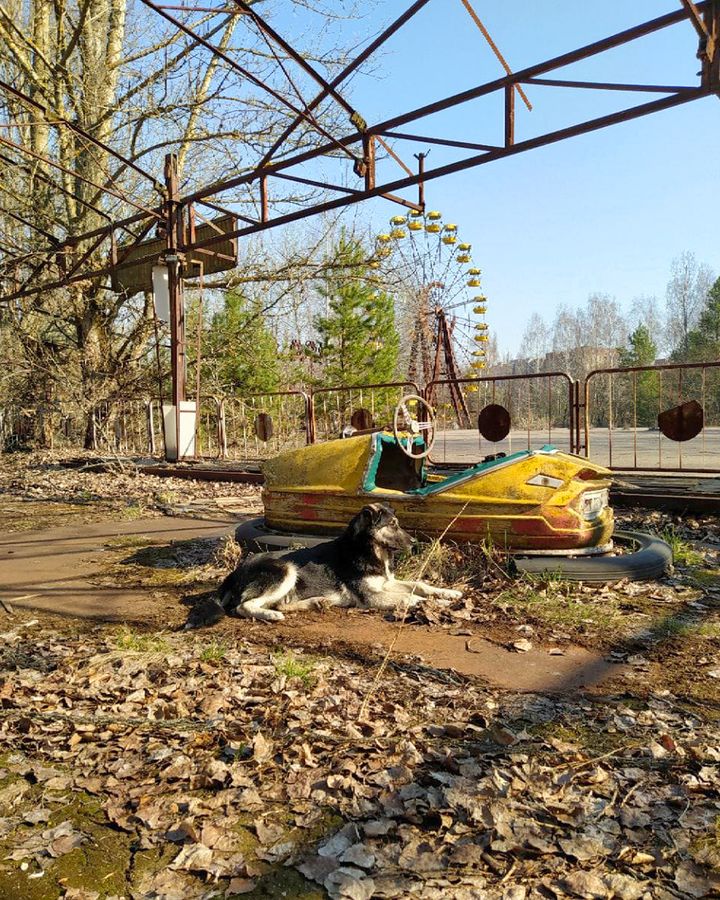
The guards used disposable cameras to capture the dogs' daily behaviour in Pripyat amusement park near Chernobyl (Credit: Chernobyl Guards/Jonathon Turnbull)
The photos taken past the guards revealed how much they had developed companionships with the wandering dogs of the Exclusion Zone.
Turnbull published some of the resulting images and material from interviews with the guards in a paper in December. More recently, he interviewed i of the study participants again on behalf of BBC Futurity. The guard in question has asked non to be identified to avoid disciplinary activity at work, so we refer to him here by the pseudonym "Bogdan".
When Bogdan walks around the abandoned streets of the zone to bank check for stalkers, the dogs happily accompany him, he says. They e'er announced eager to run into whether he, or a passing tourist, might be carrying nutrient. Should a companion dog get distracted or run off to hunt an creature, it always eventually returns to Bogdan, he adds.
Y'all might as well like:
- The bold plan to give Chernobyl a new life
- How to summate your domestic dog's real age
- The true price of the Chernobyl disaster
The loyalty goes both ways. Turnbull says the guards sometimes go to the problem of helping the dogs by pulling out ticks embedded in their skin, or by giving them rabies injections.
Monitoring who comes and goes from the Exclusion Zone sometimes makes for a ho-hum occupation. But in that location are always dogs nearby.
At some checkpoints, the guards accept more or less adopted some of the animals. They feed them and give them shelter. But non all are then tame. During his research, one guard told Turnbull, "We can't inject Arka because she bites."
Another participant spoke of ane dog that was even more difficult to arroyo. Information technology refuses to be touched at all. "Yous should but requite her a pan [of food] and go. She waits until you leave and then she eats," the baby-sit explained.
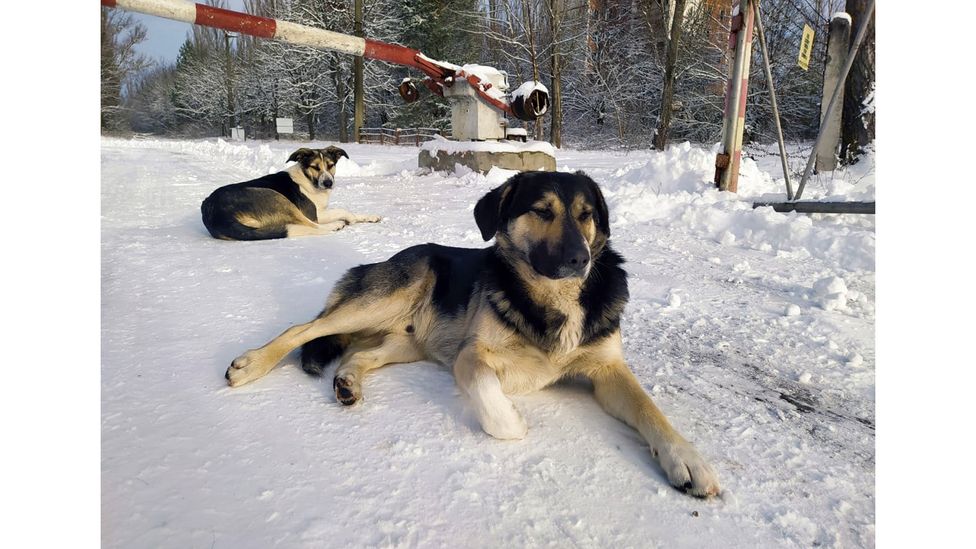
The dogs frequently hang around virtually the checkpoints where the guards are stationed (Credit: Chernobyl Guards/Jonathon Turnbull)
The dogs sometimes bark at strangers on beginning sight, that's their nature, says Bogdan. Just and so long as they don't experience threatened, they sometimes calm down and wag their tails. Occasionally it even seems as though they're grinning, he adds.
By and large, visitors to Chernobyl are advised non to touch the dogs, for fright that the animals may be carrying radioactive dust. It'south impossible to know where the dogs roam and some parts of the Exclusion Zone are more contaminated than others.
At that place is wild fauna living in the Chernobyl Exclusion Zone besides dogs. In 2016, Sarah Webster, a United states regime wild animals biologist who was working at the University of Georgia at the time, and colleagues published a paper in which they revealed how mammals, from wolves to boars and ruby foxes, had colonised the Exclusion Zone. Camera trap data showed that the animals' numbers were not noticeably lower in those areas where radioactive contamination is college.
Animals living in the Exclusion Zone are not necessarily bars there. A later study by Webster and colleagues, published in 2018, detailed the movements of a wolf tagged with a GPS device. It travelled 369km (229 miles) from its home range in the zone, taking a long arc to the south-east, then n-east over again, eventually inbound Russia.
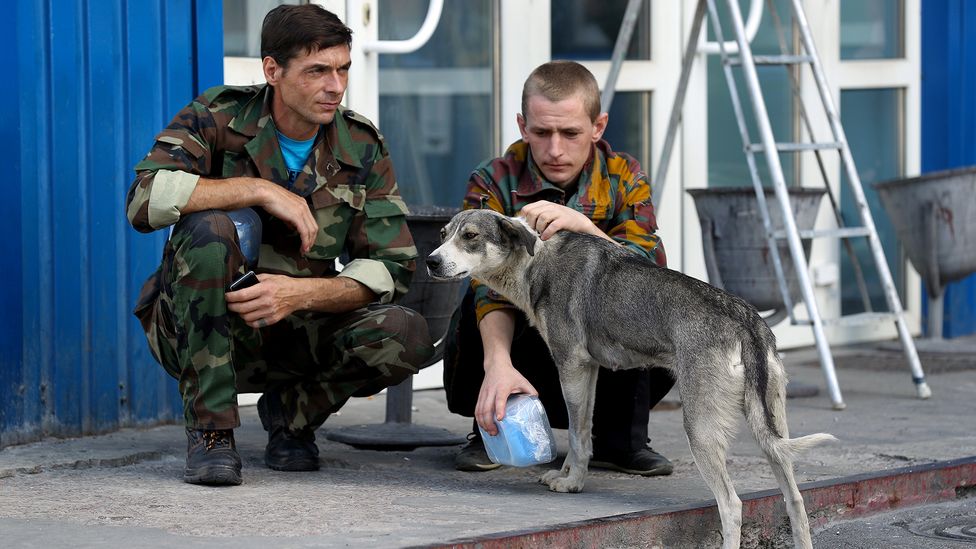
The guards in the Exclusion Zone feed and intendance for the stray dogs – and some say they help to alert them to trespassers (Credit: Sean Gallup/Getty Images)
Wolves, dogs and other animals could in theory carry radioactive contamination, or genetic mutations potentially passed on past breeding, to places outside the Exclusion Zone.
"We know it'southward happening but we don't understand the extent or the magnitude," says Webster.
Turnbull says the guards do not more often than not worry nigh radiations, though they might occasionally use dosimeters to bank check a dog over.
It really seems as though the dogs, through the companionship they offering, end upwards reassuring those who interact with them regularly, says Greger Larson, an archeologist who studies animal domestication at the University of Oxford and who was not involved in Turnbull'southward inquiry.
"They're kind of putting themselves in the shoes of the dogs," he suggests, referring to the guards. "If the dog is fine, that means yous're fine."
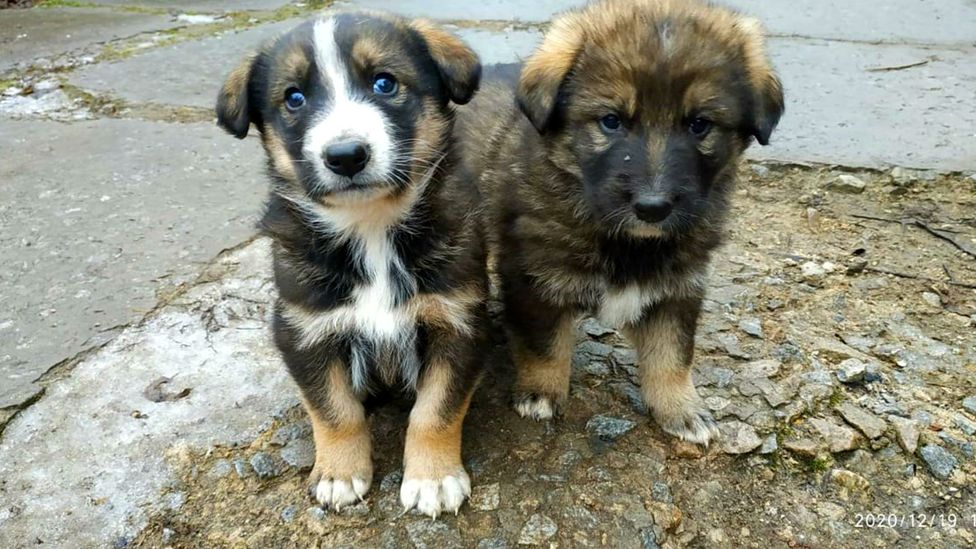
Despite living in an expanse where humans are all the same largely excluded from for safety, the dogs effectually Chernobyl are thriving (Credit: Chernobyl Guards/Jonathon Turnbull)
Just in truth, this may only be a false sense of security.
"It'due south an uncanny environment," notes Turnbull. "You can't run into the danger. Y'all're constantly aware that it might be there only everything looks normal."
Despite the fact that the dogs could pose a risk in terms of radioactive decay, guards like Bogdan instead emphasise the benefits of having them around. For case, he claims to know dogs that bawl in noticeably different ways depending on what they have spotted in the distance – a human stranger, a vehicle, a wild animal. Considering of these helpful warning signals, Bogdan thinks of the dogs as "administration".
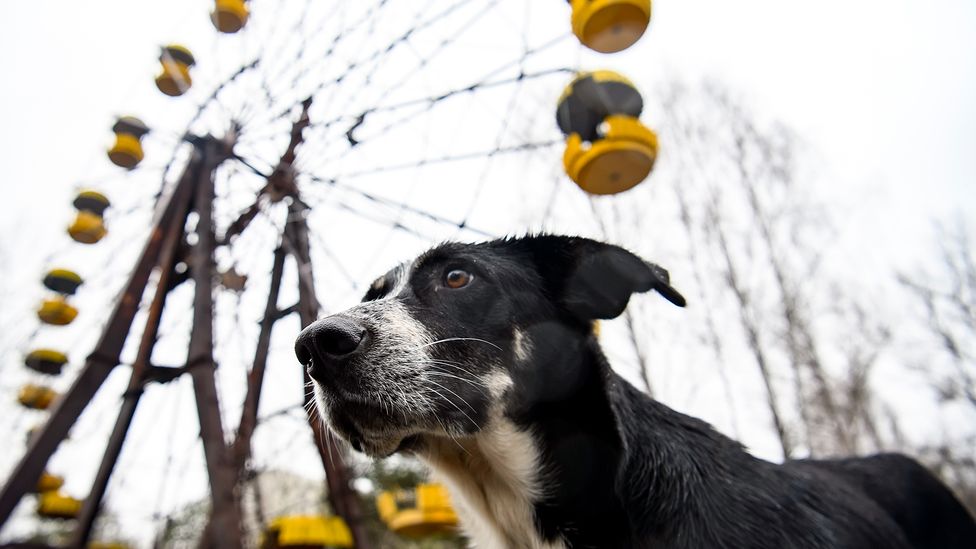
The dogs around Chernobyl take become well-nigh as famous equally the iconic ferris wheel at Pripyat amusement park (Credit: Maxym Marusenko/Getty Images)
What's happening in the Exclusion Zone is an echo of interactions with dogs that are known to accept occurred within human civilisations for thousands of years, says Larson.
"We find this for the last fifteen,000 years or more, this is what people do, they make very close associations with non just dogs just a lot of domestic animals […] to sort of say, 'this is our attachment to the mural'," he explains.
All over the world, there are dogs that inhabit a like, in-between country – non quite fully domesticated, non quite fully wild. These are the feral dogs that roam cities and industrial areas looking for food, the ones that may become to some extent adopted past people just withal wouldn't be considered pets.
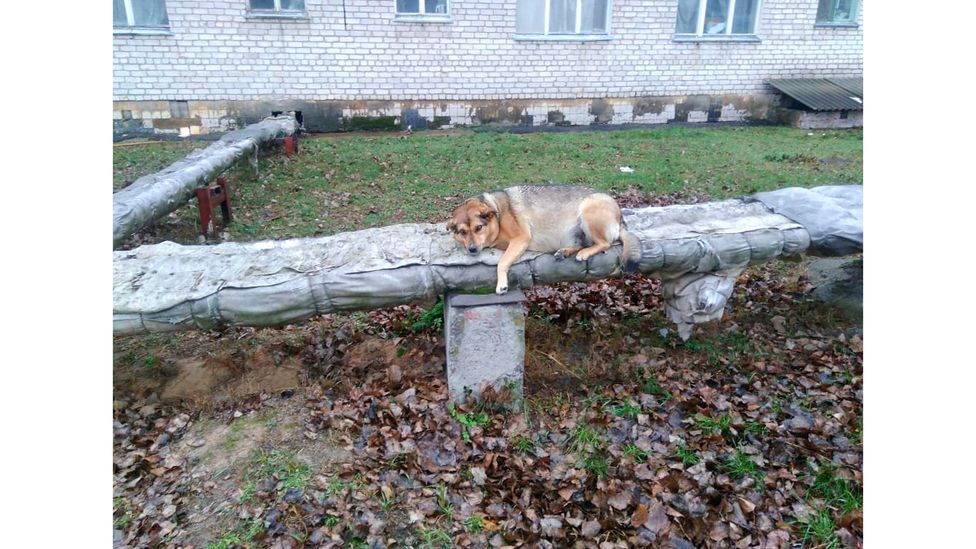
One of the dogs named Sausage keeps warm in the winter by lying on heating pipes that serve buildings used by workers (Credit: Chernobyl Guards/Jonathon Turnbull)
Chernobyl'southward dogs too live in this sort of space, on the border of domestication, simply there is a departure argues Webster, who has participated in a split study of Turnbull's in the by.
"The Exclusion Zone is very unlike in that it'due south abased past humans," she says. "The only people in that landscape on a day-to-twenty-four hours basis, actually, are the guards." As such, the dogs' opportunities for befriending humans are very limited.
While the exterior earth remains fascinated by the dogs, and their story, for many guards the connection runs much deeper. Bogdan says he is often asked why the dogs ought to be allowed to stay in the Exclusion Zone. "They requite us joy," he replies. "For me personally, this is a kind of symbol of the continuation of life in this radioactive, post-apocalyptic earth."
--
Bring together i one thousand thousand Future fans by liking us on Facebook , or follow us on Twitter or Instagram .
If you liked this story, sign up for the weekly bbc.com features newsletter , called "The Essential List". A handpicked choice of stories from BBC Future , Civilisation , Worklife , and Travel , delivered to your inbox every Friday.
Source: https://www.bbc.com/future/article/20210422-the-guards-caring-for-chernobyls-abandoned-dogs
Posted by: simpsonderignatim.blogspot.com

0 Response to "How Come Animals Can Survive In Chernobyl"
Post a Comment